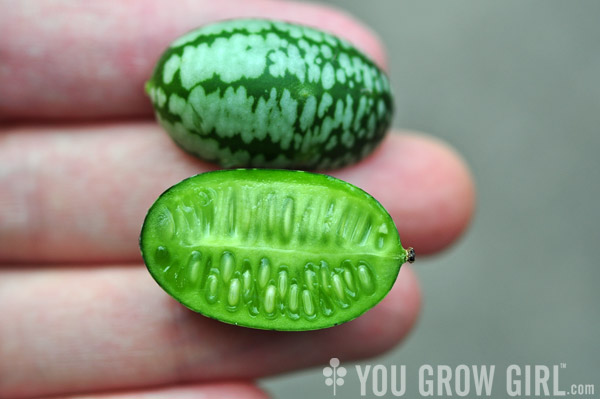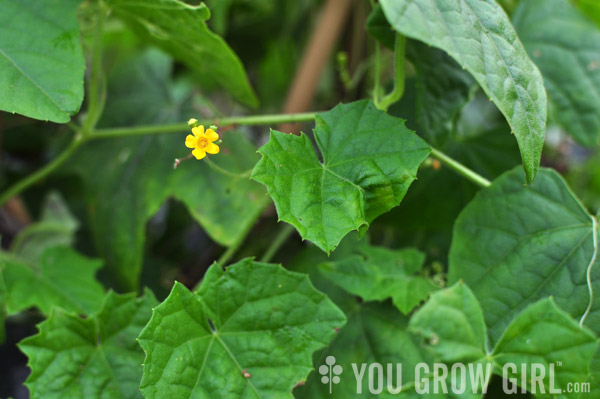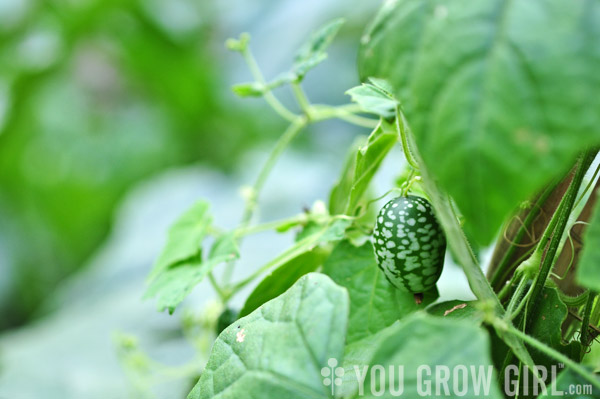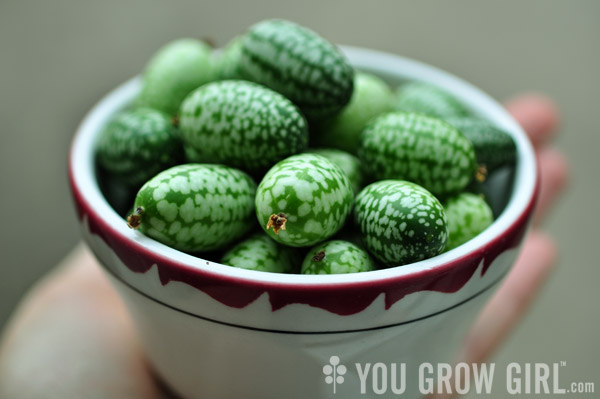
Barbie Doll Watermelons, that’s what I call them, because, well… that’s what they look like. Their real name is Mexican Sour Gherkin (Melothria scabra), but they also popularly go by mouse melon, cucamelon, and sandíita (meaning little melon in Spanish).


Mexican Sour Gherkin is a rampant vining plant with small, decorative leaves that remind me of a watermelon, but much, much smaller. It hails from Mexico and Central America (the name kind of gives it away), producing diminutive, cucumber-like fruit that are slightly tangy on the outside and fresh and watery inside. They are good in salads, stir-fried, or pickled, but most of my crop never make it as far as the kitchen as its tiny size and freshness makes it a great snack while working in the garden.
Unlike either cucumber or melons the plant is incredibly easy to grow. I first started growing it in my community garden and despite changes in location and growing conditions, I have never had any trouble producing a healthy crop. The plant is drought tolerant and doesn’t seem to have any pests that I have encountered. Seedlings often start out small and frail-looking and just when you think it will never grow it finally does. And once it starts, it will keep producing more and more fruit until the frost takes the whole plant down. It’s only real issue is that it seems to need sun to really get going. For years I thought it was warmth that it needed, but this year has been unseasonably cool and it is as vigorous as ever. However, a plant that I placed in a shadier spot has not been as productive as the plant that is out in full sun. Soil nutrition is also a contributing factor — treat it as you would any other cucumber. My experience also suggests that like cucumber it prefers a protected spot out of the path of strong wind.

This year (2019) I am selling a very limited quantity of Mexican Sour Gherkin seed through my seed shop.
The Details:
- Open-pollinated
- Start seed when you sow other cucumbers. In cooler climates, start indoors underneath lights and move outdoors after the last frost.
- Save seed from ripe fruit that has fallen to the ground.
- Harvest and eat fruit at just about any size.
- Super productive — regularly check around the leaves as well as the ground for ripe fruit.
- Give it a warm spot in full sun and water well until the plant is established.
- Be sure to situate it in front of a large and strong support structure. I did not make a large enough structure this year and I had to cobble something together with larger bamboo poles when it outgrew a smaller frame.
- Great for small spaces as it doesn’t need a lot of space on the ground level — grow it upward and sideways as an attractive and edible privacy screen.
- Urban Gardening: It’s drought tolerant and disease and pest resistant nature makes it a good choice for community garden plots that you can’t tend to regularly.
These are going into our garden next year! The kids will flip over them!
They’re great for kids!
Sometimes, I wanna grow something just because it’s cute. And this will be on my list now!
So that’s what those weird little experimental things in my garden are! I had a friend who gave me a plant this spring and said “Here, try this. I’m not sure what it is but I think it’s a cucumber of some kind.” It recently started producing little fruits and I’ve been completely perplexed. Mystery solved! Thank you. :)
I bought a pint of these at the market this week without knowing what they were.
Once I got home and tried them I was kicking myself for not finding out because they were so yummy I wanted to grow them next year.
Now I know. Thanks Gayla!
From colossal to cute!
Ha! You’re right!
I was excited to grow these a couple years ago thinking they would be great pickled whole. Unfortunately they turned out mushy in a typical vinegar/water/salt brine. How do you pickle them so theystay crunchy?
I haven’t tried canning them yet, so my best guess is that the water bath processing is where it’s going awry. How long did you process for?
Where did you purchase seed from? I haven’t seen these in Western Canada, nor in any seed catalogues.
I am interested in the unique, and OP heirloom varieties of plants.
Thanks Gayla!
I had trouble finding them too, so I hoped on ebay and got them from a fellow gardener :)
How cool are those? I love it. This is something else I will add to my plant list for next year.
I don’t think I’ve ever seen a cuter vegetable! I like snacks in the garden, but my lemon cucumbers are too thick-skinned and prickly.
I have to try these next year, just because!
I grow eggplant just because too. Just because it’s such a pretty plant, with pretty flowers, and pretty fruit. I don’t like to eat it though.
A very dapper little cucumber! And with its prolific vine it looks like it would add an element of intrigue to the garden…
Where can I get the seed I live in Alberta .Thanks Sharon
I didn’t buy these so I can’t recommend a specific seller. I would just suggest doing a search. They’re not particularly hard to find anymore.
These are groovy! DId I mss where to get the seeds? Got to grow them ! YUM!
A must for my Potager next year! Love these. I can almost taste them.
I am so excited! At a restaurant tonight, I encountered these little cuties in my salad and, thanks to you, I knew exactly what they were. Tasted good too-refreshing and cucumber-y.
They are so tiny! Might have to try planting these next year!
I’m growing these this year both in the garden and on the balcony for the first time here in Switzerland, central Europe.
Fun indeed, like dollhouse watermelons. The fruits from the garden are a tiny bit bigger. I’m pickling some tonight.
Those are so small, I want some!